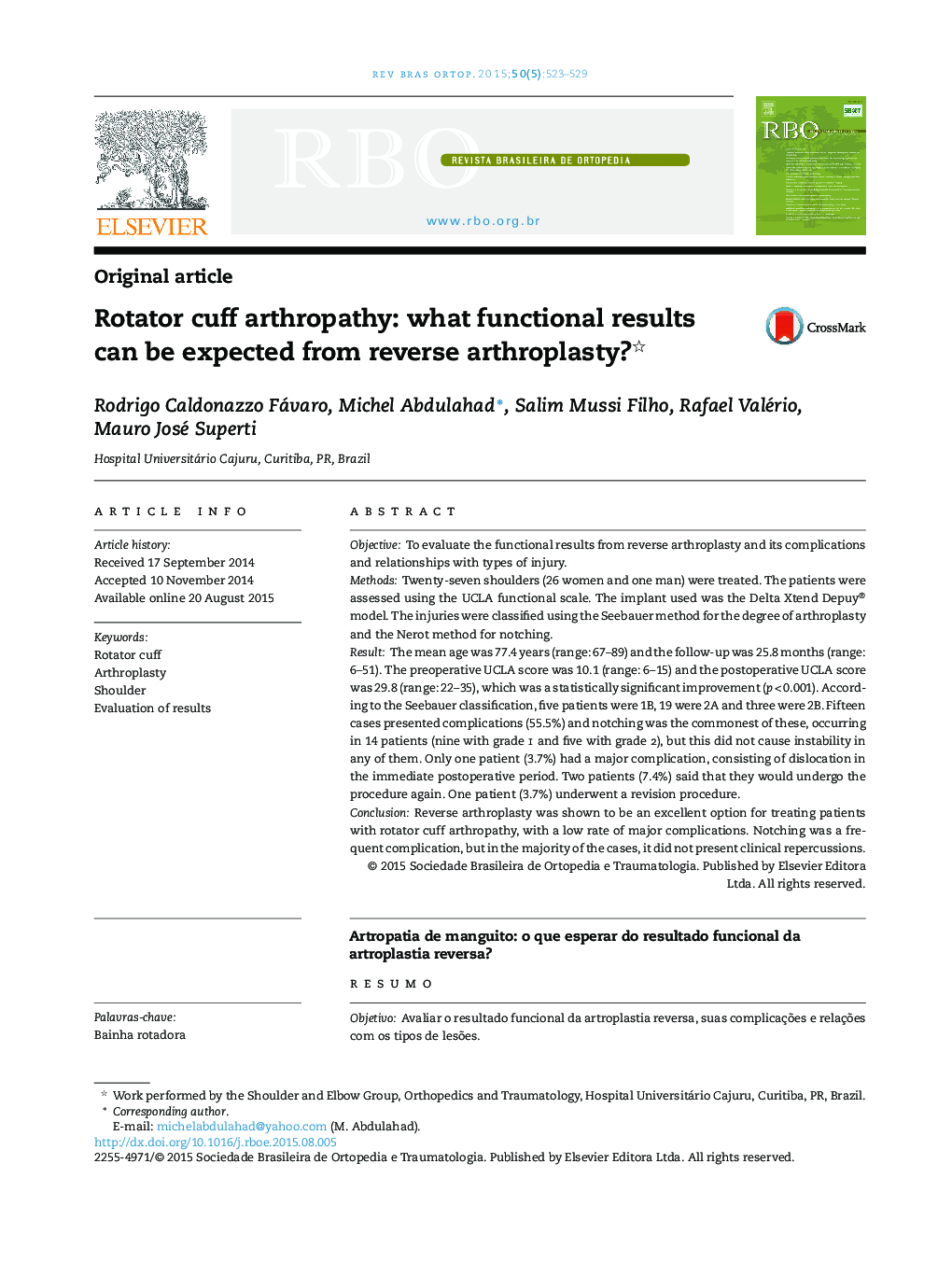| کد مقاله | کد نشریه | سال انتشار | مقاله انگلیسی | نسخه تمام متن |
|---|---|---|---|---|
| 2718171 | 1145466 | 2015 | 7 صفحه PDF | دانلود رایگان |

ObjectiveTo evaluate the functional results from reverse arthroplasty and its complications and relationships with types of injury.MethodsTwenty-seven shoulders (26 women and one man) were treated. The patients were assessed using the UCLA functional scale. The implant used was the Delta Xtend Depuy® model. The injuries were classified using the Seebauer method for the degree of arthroplasty and the Nerot method for notching.ResultThe mean age was 77.4 years (range: 67–89) and the follow-up was 25.8 months (range: 6–51). The preoperative UCLA score was 10.1 (range: 6–15) and the postoperative UCLA score was 29.8 (range: 22–35), which was a statistically significant improvement (p < 0.001). According to the Seebauer classification, five patients were 1B, 19 were 2A and three were 2B. Fifteen cases presented complications (55.5%) and notching was the commonest of these, occurring in 14 patients (nine with grade 1 and five with grade 2), but this did not cause instability in any of them. Only one patient (3.7%) had a major complication, consisting of dislocation in the immediate postoperative period. Two patients (7.4%) said that they would undergo the procedure again. One patient (3.7%) underwent a revision procedure.ConclusionReverse arthroplasty was shown to be an excellent option for treating patients with rotator cuff arthropathy, with a low rate of major complications. Notching was a frequent complication, but in the majority of the cases, it did not present clinical repercussions.
ResumoObjetivoAvaliar o resultado funcional da artroplastia reversa, suas complicações e relações com os tipos de lesões.MétodosForam tratados 27 ombros, de 26 mulheres e um homem. Os pacientes foram avaliados pela escala funcional de UCLA. O modelo de implantes usado foi o Delta Xtend Depuy®. As lesões foram classificadas segundo Seebauer para o grau de artropatia e Nerot para o notching.ResultadoA idade média foi de 77,4 (67-89), o seguimento foi de 25,8 meses (6-51), o UCLA pré era de 10,1 (6-15) e o UCLA pós foi de 29,8 (22-35), com uma melhoria estatisticamente significativa (p < 0,001). Pela classificação de Seebauer, cinco eram 1 B, 19 eram 2 A e três eram 2 B. Tivemos 15 complicações (55,5%), o notching foi o mais comum e ocorreu em 14 pacientes, nove deles grau I e cinco grau II, mas nenhum deles gerou instabilidade. Apenas uma paciente (3,7%) teve complicação maior, com luxação no pós-operatório imediato. Dois pacientes (7,4%) alegaram que não repetiriam o procedimento. Uma paciente (3,7%) foi submetida a revisão.ConclusãoA artroplastia reversa mostrou-se uma excelente opção para o tratamento de pacientes com artropatia do manguito rotador com baixo índice de complicações maiores. O notching é uma complicação frequente, mas que na maioria dos casos não apresenta repercussão clínica
Journal: Revista Brasileira de Ortopedia (English Edition) - Volume 50, Issue 5, September–October 2015, Pages 523–529